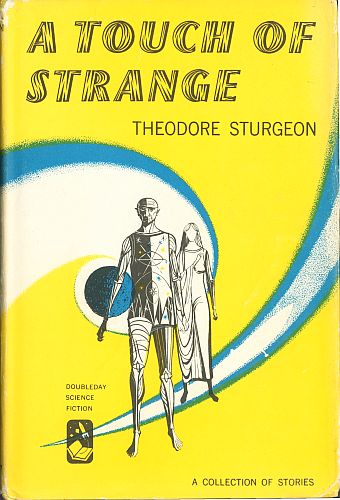

|
| Cover art by Joseph Mugnaini |
| A TOUCH OF STRANGE Theodore Sturgeon Garden City, NY: Doubleday & Company, July 1958 |
Rating: 5.0 High |
|||
| ISBN 0-? ASIN: B000NYEYDW | 262pp. | HC | $2.95 | |
This collection of nine stories is not Sturgeon at his best,1 but it comes very close. In particular, "The Touch of Your Hand" is one of the most poignant and evocative you will find in science fiction. It portrays a man whose mind has been warped by a cruel experiment, the woman who loves him, and the elder who finally explains that she can reverse the damage. The story also features an idea which might be based on Carl Jung's theory of the collective unconscious — and which is certainly original in science fiction.
Other noteworthy stories in the collection include: "Mr. Costello, Hero", one of the most unsparing dissections of the dictatorial mindset you'll read; and "It Opens the Sky"2 about a criminal who finds that despite his best efforts he's working on the side of the angels. And then there is "The Pod in the Barrier," all about the power of belief. In an Amazon review, it was claimed that this 1957 story presaged the development of spread-spectrum communications systems. That's a dubious assertion.3 Here is the relevant portion of the story:
"Whuh? Oh," said the missile expert. "I guess I was off base about the jamming. Suddenly that seems to me it's so obvious, it must have been tried before and it doesn't work." "Right, it doesn't. That's because the frequency and amplitude of the control pulses make like purest noise—they're genuinely random. So trying to jam them is like trying to jam FM with an AM signal. You hit it so seldom, you might as well not try." – Page 33 |
| 1: | The Pod in the Barrier | 13 |
| 2: | A Crime for Llewellyn | 53 |
| 3: | The Touch of Your Hand | 84 |
| 4: | Affair with a Green Monkey | 128 |
| 5: | Mr. Costello, Hero | 139 |
| 6: | The Girl Had Guts | 165 |
| 7: | The Other Celia | 189 |
| 8: | It Opens the Sky | 207 |
| 9: | A Touch of Strange | 250 |
Some of these stories will probably strike you as bizarre. In particular, the solution to the problem posed in "The Pod in the Barrier" seems far-fetched. Yet there is some scientific basis for it, however tenuous. Note that the posited effect applies only to "cold-fusion" power plants; i.e. to quantum-theory processes. British scientist Roger Penrose has proposed that the brain works by quantum effects. This hypothesis is by no means accepted science, but it does give Sturgeon some "breathing room." And the story reads well. Even if it didn't, the other stories in the book would, in my opinion, more than make up for it. So I mark this collection at the top. And because it's hard to find Sturgeon's works in print nowadays, I rate it a keeper.
| Page 46: | ""Read what?" the captain finally repeated. "The cold-fusion formula, that's all. Written out in words of one cylinder." |
| Word choice: S/B "syllable". |

 To contact Chris Winter, send email to this address.
To contact Chris Winter, send email to this address.